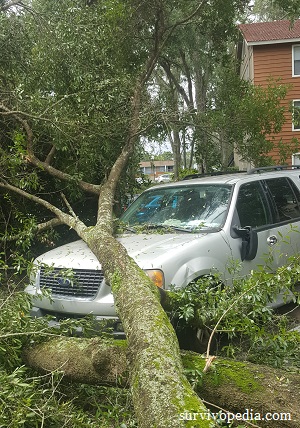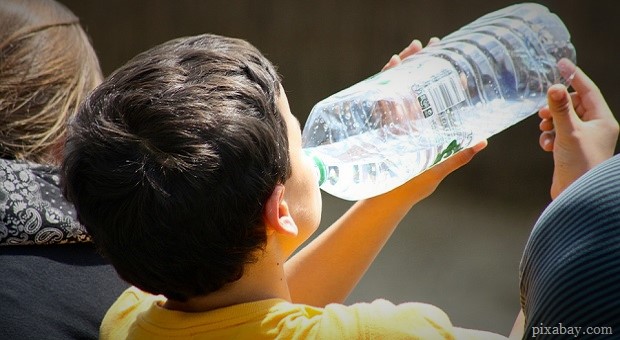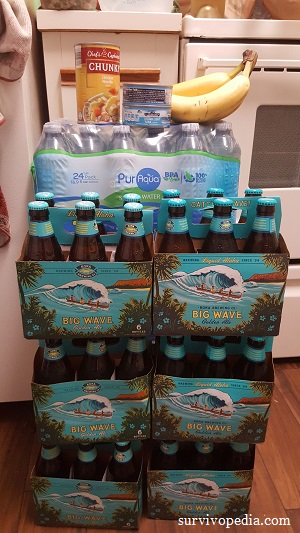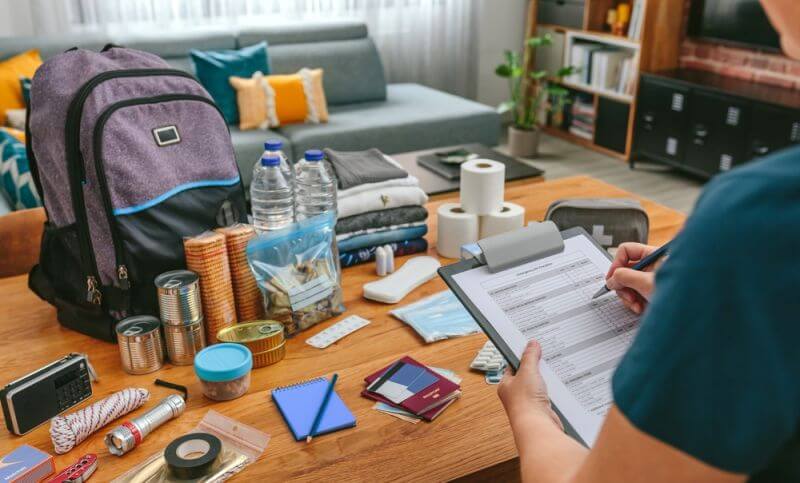You can go for several days without food, but going without water for more than a day isn’t an option.
Especially if the disaster destroyed your home or took out your power, you’ll fade fast after twenty-four hours.
Your judgement and cognitive processes will be compromised and your energy will flag. Then after a few days, your organs will shut down and you’ll die. It’s as simple as that. If your disaster involves extremes of temperature or the need to stay on the move, your window is even shorter.
So what do you do to stay hydrated when you’re in a disaster?
Prepare in Advance!

Of course, after the emergency is past, they’ll return it all en mass (seriously – I’m writing this immediately post-hurricane and it’s happening as I type). But that won’t do you any good for the days that you may be out of power.
So, it all goes back to being prepared before the emergency is upon you. Most everybody drinks bottled water so keep a couple of cases around. Restock as you use it then you don’t have to worry about that dingbat that believes the sky is falling and she needs 15 cases of water and 40 cans of tuna.
Gallons of water are dirt cheap, too, and you can get more water into the same space as a case would consume.
If you don’t have enough stocked back to allot a gallon per person per day in case you lose power or something else interrupts your access to water, get it in gear. As soon as you hear the first whisper of a significant weather event, go shopping.
Please, though, buy what you need, but don’t be ridiculous about it. A gallon of drinking water per person per day is enough for hydration and minimal personal needs such as brushing your teeth or cooking a can of condensed soup.
When calculating your water needs, take extreme weather into account. If your power is out and you don’t have air conditioning – or heat – your body will need more water to stay hydrated. In the heat, you’ll sweat it out. So include at least an additional 8 ounces, and 16 are better.
If you’re going to be working hard and sweating profusely, allow an extra 36 ounces. As a baseline to determine your water needs if you’re inside and not sweating it out, divide your body weight in half and that’s the number of ounces your body needs. If you need to trim it back a little, that’s fine for a short time. But don’t cut it back by much.
You Don’t Need Bottled Water
If you don’t have the space to stockpile enough water on a regular basis, or you just got caught unprepared, then chances are good that you’ll be facing empty shelves at the store.
I personally always keep a couple of cases of water around just because we go through it, but when that a hurricane is heading our way, I stockpile tap water in milk jugs.
I don’t recommend storing water in milk jugs long-term because the plastic is thin and easy to puncture, but for the short-term, they’re great. There’s nothing wrong with faucet water in the case of emergency, and it won’t cost you anything over your regular water bill.
This Device Easily Turns Air Into Water!
The same thing goes for ice. Most of us are big fans of multi-purpose products, so once you fill up your jugs with water, pop them in the freezer. Then you’ll have ice and drinking water in the same container, and solid blocks of ice melt much slower than smaller cubes.
One water need that many people don’t consider is having enough to flush the toilet. After a few days in 90-degree weather, an unflushed toilet gets foul and can actually be a health hazard.
So what do you do? Fill up the bathtub before the storm! That water will even work for drinking water if need be or can be used for personal hygiene or washing the dishes before you use it to flush the commode.
Consider Alternate Hydration Methods
It’s always the water that people rush to snatch off the shelves, but it’s not your only option for proper hydration.
It’s most certainly the best, but it’s not the only option. You can use sports drinks – not energy drinks! – to meet some of your hydration needs.
You can also use sparkling water, seltzer water, mineral water, or club soda because they’re just different forms of carbonated water.
Club soda usually has small amounts of table salt, potassium bicarbonate, or sodium bicarbonate to add a slightly salty flavor. It always surprises me when I see the water shelves cleared off but the club soda is still well-stocked.
Other comparable substitutes for part of your water needs are tea and coffee, but they’re diuretics, so don’t substitute more than a cup or two and go for.
Coconut water is also an excellent substitute – maybe even better for water for hydration. A note of warning for those of you who haven’t had coconut water: it’s an acquired taste and it doesn’t taste like coconut.
Sports drinks and club soda may be most effective following physical exertion because your body has just expelled minerals as well as water and these drinks are specifically designed to replace what you lost.
You may not consider it, but pre-made Jell-O is also hydrating but it’s also full of sugar, so tread carefully.
Adhere to Water Advisories
If you’re on city water, you probably won’t lose water, but that doesn’t mean it’s safe to drink. Main lines break or flood water breeches them somewhere along the way and contaminate it so pay special attention to local official warnings to boil water.
If you’re on a well, it’s always best to assume the worst and boil your water for at least a minute before you drink it. Sanitation tablets also work, but you need to let the water sit for an hour or so in order to give the sanitizing solution time to work.
This isn’t just a matter of being cautious – it may actually mean the difference between being healthy and being sick. In another article, I discussed the dangers of post-disaster contaminated water, but to summarize, the bugs that contaminate your water often cause diarrhea or vomiting – both of which contribute to rapid dehydration.
So, your drink water to hydrate and it’s swimming with bacteria that make you lose hydration. Boil and sanitize your water if there’s any doubt whatsoever about its cleanliness.
And whatever you do, don’t drink from springs, ponds, or rivers without purifying and sanitizing it first.
Water isn’t optional regardless of your situation. If you need to ration, do so, but make sure that you’re getting at least the minimal amount to keep you going. You can skimp on food to a certain extent, but water isn’t an area where you can really do that.
Prepare in advance and follow safety precautions after a disaster!
As we all know, the best way to avoid being caught without what you need is to be prepared well in advance so that you don’t have to beat the neighbors to a limited water supply.










Obi1knobi | September 25, 2017
|
Only my opinion, but 1 gallon Arizona tea jugs filled with the hottest chlorinated tap water and no air will keep safely for over a year. Just tape the date filled on the jug and recycle annually.
Bill in Idaho | September 25, 2017
|
Hi, Theresa. “Bottled Water” is just Over-Priced Tap Water ! Fruit Juice (1 Gal. size) Jugs are about the best water storage container, IF You Sterilize them ! I have 3 – 55 Gal. Drums of Irrigation water for commode and clothes laundry. I keep 40 – 50 Gals. of “Safe” water for 3 people – that’s Only 1 Gal. per person per day for 15 days or so . . . then I have to start processing canal or river water. Bill
Bob Hambidge | September 25, 2017
|
Watermelons are also loaded with water (juice) I eat them all summer to supplement the water I drink. I live in Florida as well. Not available year round, but certainly during hurricane season.
Rick | September 25, 2017
|
Rain water collection for the rain aftermath.Collapsible barrels near down spouts . RENEWABLE!!!!
Mahatma Muhjesbude | September 25, 2017
|
Beer Is water too?! Just sayin’…
And don’t forget your hot water heater if it’s a conventional one. They average about 40 gallons for a standard household and it’s always filled and there’s’ a hose type faucet at the bottom. It should be pretty sanitary as is from all the heating for constant hot water, And if it’s a gas powered unit, it should still work without electricity if it has a pilot flame that stays on as opposed to a spark igniter on the new ones, so you can turn it on high for a few minutes and ‘boil in place’!
Beth | September 25, 2017
|
5th way to solve a hydration issue: If you have no way of knowing whether your drinking water is contaminated, and you don’t have any way to sterilize it? Don’t drink it, sit on it!
Marty | September 25, 2017
|
I have a hand pump placed in my well. Pumps 3.5 gpm and will even charge my pressure tank so we can still flush and take quick showers. Also have a whole house water filter and reverse osmosis at the kitchen sink, but I really want a large gravity type filter for the kitchen counter.
Beth | September 25, 2017
|
There is a fifth way to solve hydration during a disaster: If you fear your water source is contaminated, but you lack the means to purify it–Don’t drink it, sit on it! We can re-hydrate via the intestines, and reduce the threat of illness.
kenneth dluhy | September 25, 2017
|
Also have 35 – 50 gallons of water in water heater. In a true emergency you could drink the water in the toilet tank, not the bowl. Easiest way is to water in jugs & fill tub like you said.. We have always filled the tub when it calls for severe storms or crazy snow. Heavy snow & ice can take out power.
Ursula Kolb | September 26, 2017
|
I have lived in mexico city for extended periods of time. I was taught to disinfect produce with iodine (7 drops per gallon H2o). In Mexico it’s called Yoda para bebir. It also works to disinfect water. (Most border cities share water treatment facilities and large cities in mexico have chlorinated h2o. Many plants also contain moisture. I live in the sonoran desert and many of our cacti store water. Once when I was hopping a freight train from vegas to salt lake city the train stopped for hours in the middle of nowhere in southwest Utah; we ran out of water but kept hydrated with oranges. It is also helpful not to pack food that will dehydrate you such as chips and other salty stuff.
Joseph Chartreuse | September 26, 2017
|
When buying water for storage, try and find gallons of distilled water. It’s a little flat tasting, but has two advantages. One, it’s the cheapest water per gallon due to the flat tast,e, and two- because it is distilled, killing any germs that may be present in other water- will be the safest to drink over the longest period.
Joseph Chartreuse | September 26, 2017
|
I really wanted to know about the device that turns air into water- probably some sort of dehumidifier. Unfortunately, like many of these ads, one has to sit through a video that supposedly justifies buying the product. The video went on and on to a point where I did not want to invest any more time into it. I wish there had been a link where I could just learn about the product. Just a stupid way to market….
Survivopedia | September 26, 2017
|
Joseph, a text version is also available if you try to close the video, then choose the “stay on page” option. This works for all out products.
I hope it helps, and thank you for being interested in our product.
C Schultz | July 18, 2019
|
You can press a button for an option to read it at the beginning vs. watching. Bottom line $39.00 gets you the material list, directions “that anyone can follow”, customer support and a 60 day satisfaction guarantee. Materials will cost around $270.
If it actually works like they say it’s a mighty cheap investment! I haven’t bought it yet, but am seriously thinking about it.
mark haney | February 3, 2020
|
sat through the video, really expensive and don’t make that much water.
A williams | September 26, 2017
|
A lot of people don’t know there are 40-50 gallons of water available in their hot water tank. You just need to shut of the intake water before an event, put a hose on the tank and potable water.
Mr. Gray | September 26, 2017
|
I have a Rain catchment barrel ATTACHED to a downspout. I’ve learned that you must periodically clean such barrels out because vegetation gets in, rots and fouls the water. Still, rainwater is an excellent method of obtaining extra water.
I also have two Ceramic filter devices. My plan is to first boiL the rainwater, then filter it to remove particulates.
In addition to the water in my water heater, full bathtubs and stored bottled water this should give me About 175 gal.
tom o | September 27, 2017
|
Lifestraw, or other type of filter. I never leave home without one
James | September 27, 2017
|
You’re forgetting how to get water from the air, Yes rain water is awesome but there are a couple other ways to get water out of the air if you’re really desperate. Can you show us how to get water from a tree? Or setting up a still with a piece of plastic, a coffee can, a rock and a hole in the ground? You may have already, not sure. Thanks
Cyberrifles | August 24, 2018
|
I would not use water for the toilet. I keep a portable toilet with special plastic bag under it. You put this liquid in the bag. When the bag is full, you bury it in the back yard.
William Halford | August 24, 2018
|
Like was said in the article but probably not stressed enough, save containers that water can be put in. There’s no need to buy, and pay more for bottled water, when you’re already paying to tap water. Filling with hot water will help create a vacuum, so that the water will be less likely to have bacteria grow in it. And if you then put it in a refrigerator, it will last even longer.
And like was said, freeze water in pots and pans. It’ll keep your freezer cold longer. You can transfer some to th refrigerator, as-needed, to keep it cool longer. And when the ice melts, it’s still good drinking water.
When I lived in Florida,, I had a second refrigerator/freezer. I kept containers of tap water in the refrigerator at all times. I kept containers of water frozen in the freezer. That’s all I used the second refrigerator for, so that it was ready for when the power and/or was out. So when a hurricane was coming, all I had to do was be sure I had containers of water to put in the main refrigerator.
Yosemite | September 14, 2018
|
The colored milk jugs are actually thicker than the clear 1 gallon water ater jugs…. sterilize the milk jugs and rinse thoroughly.
also don’t forget all those 2 liter and 1 liter drink and soda bottles.
Also we have water cooler inside the house and several 3 gallon jugs one can get 5 gallon jugs but the are heavier too move and replace
No one has mentioned the purified water machines that use Reverse Osmosis and filters outside or inside grocery stores or even Walmart……..
1 gallon of water can vary from 35 .45 cents per gallon….Lot cheaper than buying a jug inside the store……..
We also have a pool we can use for washing clothes or our bodies and flushing toilets or boil for drinking………
.
Marty | September 14, 2018
|
RO and filters are good. but I don’t believe they are good for bacteria and such. I use them both at my house, but I have the water checked about every other year for anything dangerous.
Jefferson NWENGLAND | January 3, 2020
|
A Ultra violet system would kill any remaining nasties.
Low power consumption,should easily run off a small solar panel and battery.
That I think would be a supreme system.
Or chemical treatment, but this feels to me like the least favourable.
Lisa | April 21, 2020
|
Haven’t done the pool thing yet. Water in AZ is never far from my mind. I’m not a pool person, but look at the potential storage. I may seriously think about a pool. Legal and no permits like a cistern.
George | September 14, 2018
|
Do not forget your can goods. Fruits and vegies have water or juice as a packing material. You can cook the vegies in that liquid then let it cool before drinking it. Lots of vitamins and minerals are in that fluid. Using that fluid as a soup base and adding fish or meats packed in water not only hydrates, but makes an excellent meal. Hard candies allowed to dissolve in your mouth will help quench thirst. Soft drinks and canned juices (like tomato juice) should also be in your storage locker.
Evan | September 14, 2018
|
One thing to remember when retrieving water from the water heater is that any sediment goes to the bottom of the tank where the drain valve is located.. It is recommended to drain several gallons out first at least twice a year and more often if you have a well. Fine particles always seem to escape the filter(s). You still use this water for the toilet or garden.
Pingback:7+1 Tips For Cleaning Up After Floods | Survivopedia | November 8, 2018
|
Bob | July 16, 2019
|
I have seen a lot of references to using milk jugs and pop bottles. These are not recommended because the sugars and other “stuff” left behind can ruin the quality of your water very quickly. I buy the distilled water in jugs and re-use those jugs for drinking water. I also use my camping water containers, don’t forget that all your camping stuff can help in an emergency. I use the bath tub, rain barrels, hot water tank and old laundry detergent containers for water I need for the toilets. I have to deal with both warm and cold weather options due my location. I boil down snow on the wood stove, use my lifestraw or Sawyer products and use the iodine as a last resort due to the terrible taste.
Stay safe!
Pat | July 16, 2019
|
What people don’t realize is that a can of tomato soup prepared will re-hydrate you faster than an entire IV bag will.
Lisa | April 21, 2020
|
I think the whole bottle water is a marketing hype. The bottle is a vessel to store. I keep some in the house for workman and guests. I take a clean one and refill it. A lot less money.
Jack | July 16, 2019
|
It sounds like no one has read the problems with bottled water. It’s not healthy. It also contains nano-particles of plastic. Don’t drink it!!
rod Clark | September 28, 2019
|
If SHTF & drinking water is essential I will drink bottled water rather than die from dehydration.
William | April 18, 2020
|
Rod has a point. Plus, there’s some bottled water plastics that are safer, even if not as safe as glass or stainless steel for water containers. and yes, I avoid drinking bottle water unless I have no choice.
And rather than only rant about bottled water, you should also be talking about plastic containers used for ALL drinks and foods, not just bottled water.
SkiptheBS | July 17, 2019
|
I use my unscented chlorine bleach bottles to store water. The residue of chlorine left in the bottle will sterilize the water the first time; add some more on subsequent uses. The bottles are far stronger than milk bottles and you have less chance of organic residue causing spoilage.
Jefferson,NW England | September 28, 2019
|
Beer has been used for centuries to sterilize water.
Just make the alcohol level low.
Nelson | September 28, 2019
|
I use glass bottles ie; pop,wine, filled with water from britta water filter. Add pure lemon juice, or allum to preserve it. One gal. Of water with two teaspoons of alum good for at least one year. I also store water in food grade 1gal. Buckets. During spring, summer and fall u can use maple surup taps to get water from trees. Works up to the time tree drops its leaves.. every one should have enough non perishable food for two meals per day for at least 32days.
Mike | September 28, 2019
|
For the last two days I’ve heard, on the radio, that skim milk is the best rehydrater due to it’s ability to retain the water for absorption vs water in – water out. Ever hear of this science?.
Zdenko Petrinovic | July 24, 2020
|
I did npt get my copy: [email protected]
Order Number: HMDK6AMZ
Alex | July 27, 2020
|
Hello,
Thank you for your message. One of my colleagues will contact you ASAP to help you track your order and see what happened to it.
Stay safe!
Leland Freeborn | July 24, 2020
|
SAFE WATER http://www.parowanprophet.com/Nuclear_War_Comes/water_water_water.htm